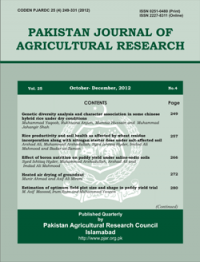STABILITY ANALYSIS FOR ECONOMIC TRAITS IN SESAME ( L.)
Muhammad Yasin Mirza*, Mubashir Ahmad Khan*, Muhammad Amjad* and Malik Shah Nawaz*
ABSTRACT
This study examined 10 elite genotypes of sesame across three locations for the estimation of genotypes environment(GE) interaction and to identify stable genotype(s) using stability parameters, and to determine inter-parameters correlation. Two locations (NARC and D.I. Khan) were suitable for high productivity. PR-19-9-S produced maximum (341 kgha ) at NARC and V-90005 produced 344 kgha and PARS-I produced 304 kgha at D.I Khan. The variance due to GE interaction was highly significant for all the traits showing heritable variation among the genotypes. The linear component of GE interaction was also significant for all traits except branches per plant. Pooled deviation was significant only for yield indicating the differential genotypic response across the locations. The significant variance due to environment (linear) indicated that the performance of genotypes was under genetic control. The b-values of V-90005, T-89 and PARS-I were larger than unit regression; hence were suitable for favourable environments for yield. Whereas, V-III and SangharI were with b-values less than unity indicating their below average response. For branches per plant, Sanghar-1 and S-17 had regression coefficients less than one with negative sign making them suitable only for poor environment. Four genotypes namely, Sanghar-I, S-17, PR-19-9-S, and Rattodero-1 had greater than unity and non-significant regression coefficients with high response towards better agronomic conditions and were stable due to low deviation from regression. Correlations of mean with b-value and S d, for seed yield were highly significant and positive suggesting that average yield could be considered as a measure of response and stability.
To share on other social networks, click on any share button. What are these?







